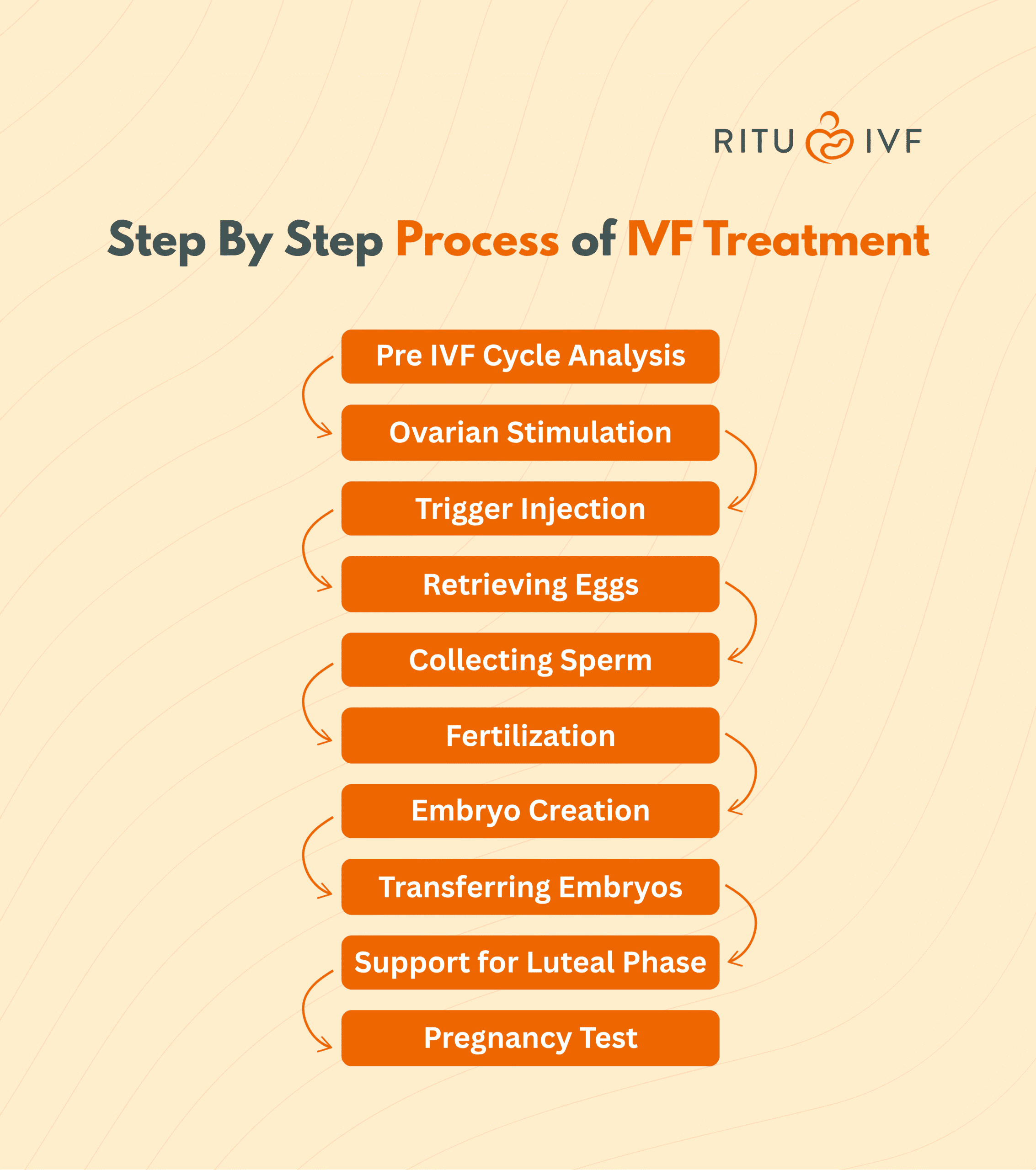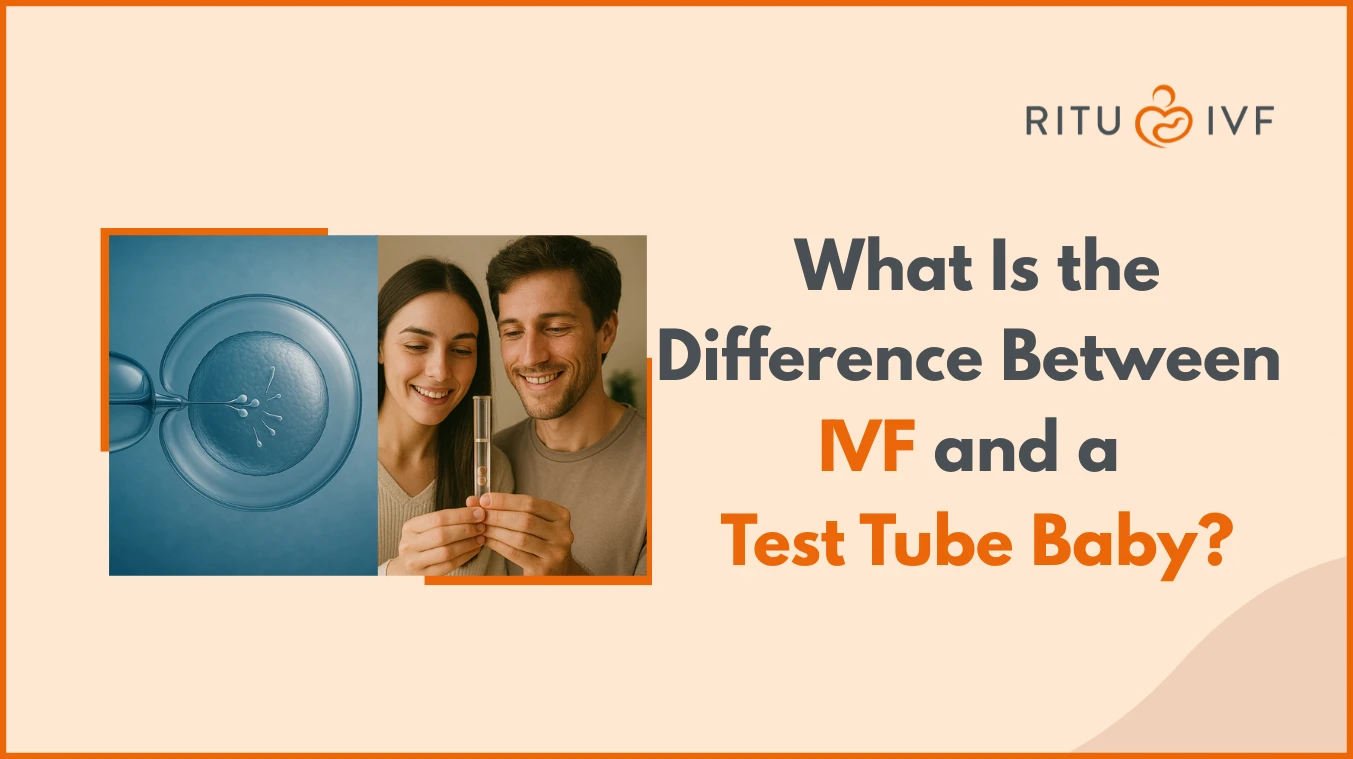When it comes to considering assisted reproductive techniques, couples often wonder about the difference between IVF and test tube baby. In comparison, these two terms are used interchangeably, which makes it even more confusing. The term “Test Tube Baby” refers to IVF treatment, also known as In-Vitro Fertilisation. Both describe the same procedure, wherein the egg is fertilized by sperm in a laboratory. However, medical and non-medical terms can make it seem like two separate things.
So, what is the difference between IVF and test tube baby? Technically speaking, there is no difference! Test-tube baby is an older term, widely used when the initial IVF procedures were gaining traction. Whereas, IVF is the accurate medical name for the process. Over time, as awareness and medical literacy increased, IVF has become the preferred term for professionals. Determining this difference enables clearing up myths regarding fertility treatments.
What is IVF Procedure?
To understand the key differences between IVF and test tube babies, both terminologies must be well comprehended.
In vitro fertilisation (IVF) is a reputable form of assisted reproductive technology (ART) in which sperm and eggs are fertilized outside of the human body. In addition, the IVF procedure entails removing eggs from the ovaries and physically combining them with sperm in a lab before fertilization. Several days after fertilization, the fertilized egg (embryo) is placed inside the uterus. Finally, pregnancy occurs when the embryo implants itself in the uterine wall.
What is a Test Tube Baby?
A Test Tube Baby is an informal term for a child conceived via the IVF process. If you’re still curious, what is the difference between IVF and test tube baby? There is no difference! A woman’s egg and a man’s sperm are combined in a laboratory dish during IVF. As the term suggests, embryos are developed and transferred (not in a test tube) but outside the human body. After fertilization occurred in the lab, it led to embryo transfer in the woman’s uterus, which helps in a successful pregnancy like natural conception.
What is the Difference Between IVF and Test Tube Baby Fertility Treatment? Does any Difference Exist?
Many couples wonder about the difference between IVF and test tube baby, but the truth is, there isn’t one! Both terms refer to the same medical procedure – In Vitro Fertilization (IVF), where an egg is fertilized by sperm outside the body. The embryos are developed in a lab dish and then implanted into the uterus. Moreover, “Test Tube Baby” is an older term, used casually, that became popular when IVF was first introduced, sparking public curiosity and a few misconceptions.
Further, many wonder whether babies are grown in a test tube. No, the eggs are fertilised and combined with sperm in a lab before being placed into the uterus, where the baby develops normally during pregnancy. The phrase may be misleading, as IVF includes a careful lab process. So, when it comes to determining the difference between IVF and test tube baby, there is no scientific distinction; it is simply two names for the same reproductive breakthrough.
Read Also –Everything You Need to Know About IVF Follicle Growth Chart
Key Reasons to Opt for the IVF Process
After understanding the difference between IVF and test tube baby, let us explore key symptoms or reasons to consider the IVF process. Couples often choose IVF for infertility issues or when one partner has a health condition. However, IVF is an ideal reproductive option for same-sex couples or individuals seeking to conceive a baby without a partner.
When to consider IVF?
-
Polycystic Ovary Syndrome (PCOS) or another ovarian disorder.
-
Blocked or damaged fallopian tubes.
-
Unexplained issues with the uterus.
-
Endometriosis.
-
Uterine Fibroids.
-
Low sperm count and other sperm-related impairments.
-
Risk of passing a genetic disease or disorder to a child.
-
Unexplained fertility.
-
Using an egg donor or a gestational surrogate for conceiving a baby.
Step-by-Step Process of IVF Treatment

IVF includes varied steps using ART. It involves stimulating ovaries, retrieving eggs, fertilizing them with sperm in a lab, and then transferring the embryo into the uterus. Commonly known as the test tube process, the difference between IVF and test tube baby lies only in the term and not in the procedure.
1. Pre-IVF Cycle Analysis
Before beginning with IVF procedures, couples have to undergo extensive medical assessments like hormonal blood tests and an ultrasound to understand their reproductive health and ovarian reserves. Upon results, your doctor will create a custom plan and explain the necessary protocols.
2. Ovarian Stimulation
-
Hormone-Based Injection: Over 8-14 days, a woman receives daily hormone injections (follicle-stimulating hormone and luteinizing hormone) to stimulate ovaries and produce multiple eggs instead of the usual single egg per cycle.
-
Tracking: Conducting blood tests and transvaginal ultrasounds to track overall follicle growth and hormonal levels.
-
Priming: Some protocols leverage oral contraceptives or even estrogen pills before stimulation to prime the ovaries.
3. Trigger Injection
When ultrasounds indicate that follicles have reached to the optimal size – 18-22 mm, “trigger” injection of GnRH or hCG is administered. This process helps mature eggs and prepares them for retrieval. However, the timing of the injection is scheduled carefully.
4. Retrieving Eggs
-
Process: After 24-26 hours of trigger injection, eggs are collected in a minor outpatient process under light anaesthesia.
-
Method: A needle is inserted through the vaginal wall into the ovaries (followed by ultrasound) to aspirate follicular fluid containing eggs. This process normally takes around 15 to 30 minutes.
5. Collecting Sperm
-
A fresh semen sample is collected (the same day as egg retrieval), or previously collected and then frozen sperm is leveraged.
-
Moving ahead, this sperm is processed and prepared to select the healthier one.
6. Fertilization
-
In the lab, mature eggs are combined with sperm in a petri dish.
-
Standard IVF: Eggs and sperm are combined and left to fertilize naturally for a specific time.
-
ICSI (Intracytoplasmic Sperm Injection): A Single sperm is injected directly into a mature egg, ideally used for male factor infertility.
-
Finally, eggs and sperm are incubated in a controlled environment. After 17 to 18 hours, the fertilization is examined again.
7. Embryo Creation
-
Embryo Development: The fertilized eggs (embryos) are tracked for 2-5 days as they develop, reaching the blastocyst stage (which is day 5 embryo).
-
Genetic Testing (Optional): In a few cases, pre-implantation genetic testing is performed to screen for chromosomal abnormalities within the baby.
8. Transferring Embryos
-
Painless Process: One or more healthy embryos are selected for transferring into the woman’s uterus by using a thin catheter. This is performed without anaesthesia and feels similar to a pap smear.
-
Timing: This transfer takes 3-5 days after egg retrieval, depending on the embryo growth.
9. Support for Luteal Phase
-
Medicine: The patient is recommended to take progesterone supplements (gel, tablets, or injection) to support embryo implantation and early pregnancy.
10. Pregnancy Test
-
Blood Test: After two weeks after embryo transfer, conduct a blood test for hCG hormone to determine if pregnancy has occurred. Moreover, ultrasound confirmation is necessary if tests are positive.
Read More – IVF Cost In India
What can Couples Expect post-IVF treatment?
After understanding, what is the difference between IVF and test tube baby? Understanding the causes of mild symptoms following an embryo transfer or IVF procedure is equally crucial.
-
Spotting.
-
Mild bloating and cramping.
-
Constipation.
-
Breast tenderness from high estrogen levels.
Final Takeaway!
The difference between IVF and test tube baby is only in medical terminology! Both refer to the same fertility procedure where the egg is fertilized outside the body. However, ‘Test Tube Baby” is just an informal phrase! Whether you call IVF or Test Tube Baby, the objective is the same, which helps couples and singles experience the joy of parenthood. Connect with our team to learn more about the IVF process.
FAQs
1. Which is better, IVF or test tube baby?
IVF and Test Tube Baby are both fertility treatments, and they are the same! The term “Test Tube Baby” is a casual or non-medical term used to refer to IVF treatment.
2. Is an IVF baby a test tube baby?
Yes, an IVF baby is often referred to as a test tube baby, as fertilization occurs in laboratory, outside the body. And then the embryo (developed in a lab dish) is implanted in the uterus.
3. What is another name for a test tube baby?
Another formal term for test tube baby is referred to as In Vitro Fertilization (IVF), which uses Assisted Reproductive Technology (ART)
4. Is the test tube baby process painful?
The test tube baby or IVF process may involve slight discomfort from injections, egg retrieval, or even hormone treatments. However, it is tolerated and not considered a painful process. Moreover, you can seek pain management options to reduce your discomfort level.







